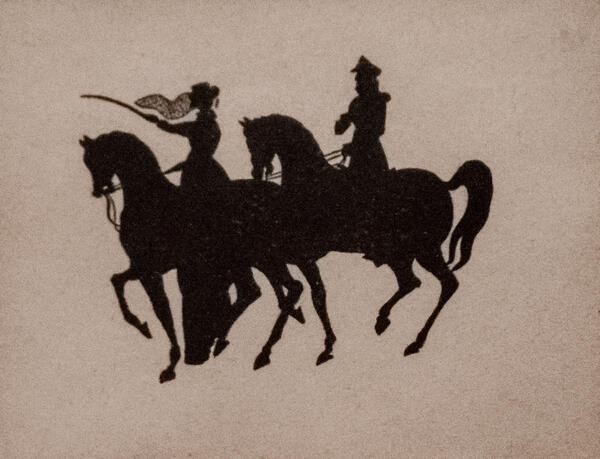Nikolay Vasilyevich Ilyin was a Soviet graphic artist, illustrator, constructivist, innovator, and an outstanding graphic designer of the 1920s.
The artist made an illustration for Mikhail Lermontov’s poem “The Tryst” using the wood engraving technique. It depicts two black silhouettes of riders from the right to the left side of the spread.
Nikolay Ilyin’s work is not framed so it seems that the riders are about to leave the pictorial space. The drawing which served as a base for the engraving was created as an illustration for the poem.
A female figure is depicted slightly ahead. To the right behind her is a silhouette of Mikhail Lermontov wearing a uniform cap and an officer’s frock coat with epaulets. With his left hand, he holds the reins, while his right hand is tucked inside the frock coat and pressed to his heart.
The horsewoman is wearing a hat with a high crown and a veil that flutters in the wind. She holds the reigns with her left hand, while a whip is in her right one. She has turned her head and now looks at Lermontov. The riders’ horses walk with their heads gracefully lowered down.
The poet’s companion in the illustration may well be Emilia Klingenberg, the stepdaughter of General Pyotr Verzilin. In 1941, Klingenberg enjoyed the courtship from Nikolay Martynov and Mikhail Lermontov at the same time. She witnessed the quarrel, which took place between the two on July 13 in the general’s house and led to their duel.
The poem “The Tryst” was written by Mikhail Lermontov in 1841 under the impression of his trip to the Caucasus. The poem was discovered by Vladimir Odoyevsky in his notebook which he had previously lent to Lermontov, “The poet Lermontov is solemnly entrusted with this old and beloved notebook of mine to return it to me by himself once it is filled with his notes.”
While the poem is expressive and emotional, the engraving is more of a decorative nature. It expresses neither the atmosphere of the East nor the depth and complexity of Lermontov’s soul.
The original drawing has not survived; the engraving was acquired from the artist’s son in 1978. It can be traced to 1936 given the date that the engraver indicated on another impression. The work was reproduced in the book “Mikhail Lermontov. Poetry”.
The artist made an illustration for Mikhail Lermontov’s poem “The Tryst” using the wood engraving technique. It depicts two black silhouettes of riders from the right to the left side of the spread.
Nikolay Ilyin’s work is not framed so it seems that the riders are about to leave the pictorial space. The drawing which served as a base for the engraving was created as an illustration for the poem.
A female figure is depicted slightly ahead. To the right behind her is a silhouette of Mikhail Lermontov wearing a uniform cap and an officer’s frock coat with epaulets. With his left hand, he holds the reins, while his right hand is tucked inside the frock coat and pressed to his heart.
The horsewoman is wearing a hat with a high crown and a veil that flutters in the wind. She holds the reigns with her left hand, while a whip is in her right one. She has turned her head and now looks at Lermontov. The riders’ horses walk with their heads gracefully lowered down.
The poet’s companion in the illustration may well be Emilia Klingenberg, the stepdaughter of General Pyotr Verzilin. In 1941, Klingenberg enjoyed the courtship from Nikolay Martynov and Mikhail Lermontov at the same time. She witnessed the quarrel, which took place between the two on July 13 in the general’s house and led to their duel.
The poem “The Tryst” was written by Mikhail Lermontov in 1841 under the impression of his trip to the Caucasus. The poem was discovered by Vladimir Odoyevsky in his notebook which he had previously lent to Lermontov, “The poet Lermontov is solemnly entrusted with this old and beloved notebook of mine to return it to me by himself once it is filled with his notes.”
While the poem is expressive and emotional, the engraving is more of a decorative nature. It expresses neither the atmosphere of the East nor the depth and complexity of Lermontov’s soul.
The original drawing has not survived; the engraving was acquired from the artist’s son in 1978. It can be traced to 1936 given the date that the engraver indicated on another impression. The work was reproduced in the book “Mikhail Lermontov. Poetry”.



